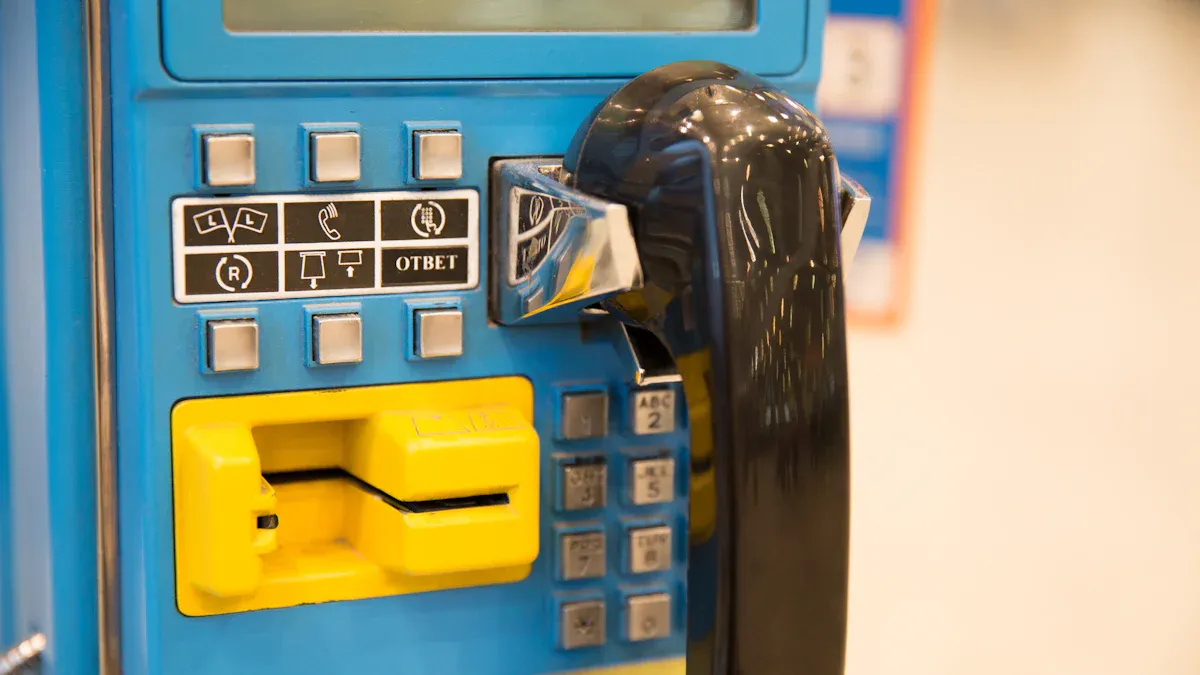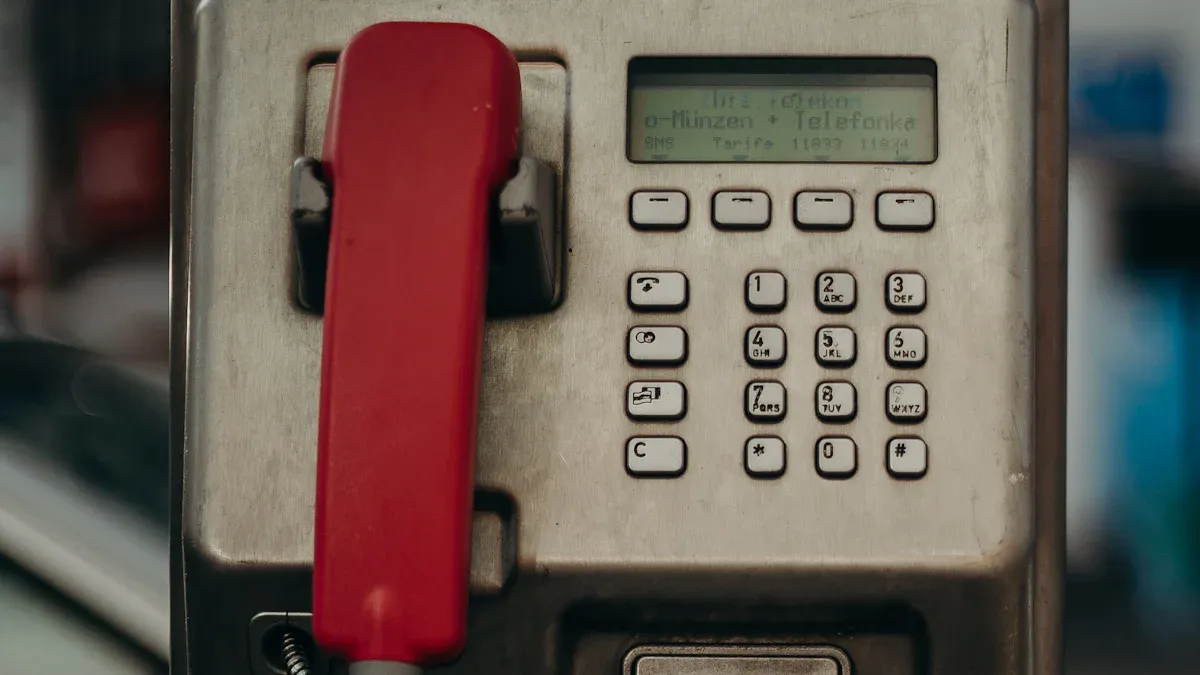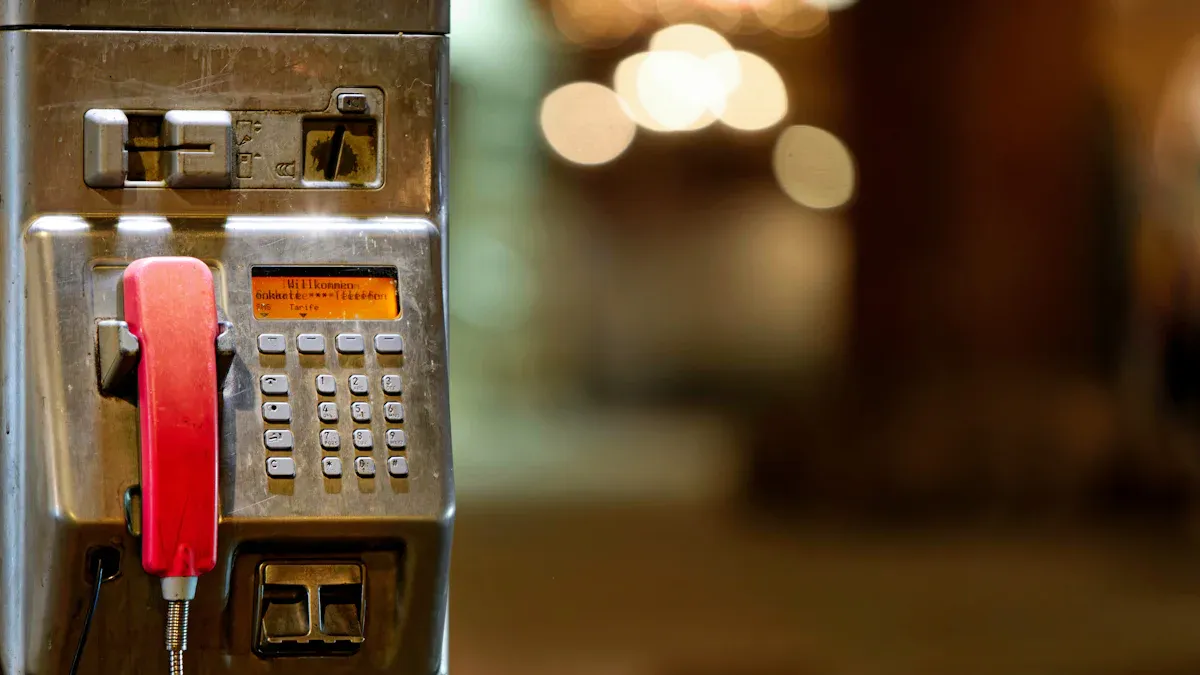
A Payphone Telephone Handset is a sturdy device crafted for public use, providing reliable communication through its receiver, which captures sound, and its transmitter, which converts your voice into electrical signals. Its ergonomic design ensures a comfortable experience during use. This durability makes it an ideal choice for secure environments such as correctional facilities, where a Jail Telephone Handset is a necessity. Furthermore, certain models, like the Anti Radiation Telephone Handset, are designed with user safety in mind, minimizing exposure to electromagnetic waves for added protection.
Key Takeaways
- A payphone handset has four main parts: receiver, transmitter, cord, and keypad. Each part helps make calls work.
- Payphones are still useful today in emergencies or secure places. They provide reliable communication when needed.
- Knowing how payphone parts work together helps you value this old communication tool. It has both historical and cultural importance.
Key Components of a Payphone Telephone Handset

The Receiver: Capturing and Delivering Sound
The receiver is the part of the handset that allows you to hear the voice of the person on the other end. It contains a small speaker that converts electrical signals into sound waves. When you place the receiver close to your ear, it delivers clear audio, ensuring you can understand the conversation.
Tip: Always hold the receiver properly to avoid muffled sound or interference.
Modern receivers are designed to minimize background noise, making them ideal for use in noisy public spaces. This feature ensures that communication remains effective, even in challenging environments.
The Transmitter: Converting Voice into Electrical Signals
The transmitter is the component that captures your voice and turns it into electrical signals. It uses a microphone to pick up sound vibrations when you speak. These vibrations are then converted into signals that travel through the payphone system to reach the other party.
Transmitters are built to be sensitive enough to capture your voice clearly while filtering out unnecessary noise. This ensures that your message is delivered accurately, even if you’re speaking softly.
The Cord: Ensuring Secure Connection
The cord connects the handset to the main body of the payphone. It is typically made of durable, reinforced material to withstand frequent use and potential vandalism. The cord ensures a secure connection between the handset and the payphone system, allowing uninterrupted communication.
- Features of the cord:
- Durability: Designed to resist wear and tear.
- Flexibility: Allows easy movement of the handset.
- Security: Prevents accidental disconnection during use.
Without the cord, the Payphone Telephone Handset would lose its functionality, as it serves as the physical link to the payphone system.
The Keypad: Enabling Number Input
The keypad is an essential part of the payphone handset. It allows you to input phone numbers and access various features of the payphone system. Each button on the keypad corresponds to a number or symbol, and pressing them sends signals to the payphone’s internal system.
Keypads are designed to be user-friendly, with tactile buttons that respond to your touch. They are often made of durable materials to withstand heavy usage in public spaces.
Note: Some payphones also include additional buttons for special functions, such as redialing or accessing operator services.
The integration of the keypad ensures that you can easily connect with the desired number, making the Payphone Telephone Handset a complete communication tool.
How Payphone Telephone Handset Components Work Together
Signal Flow Between Receiver and Transmitter
The receiver and transmitter work as a team to make communication possible. When you speak into the transmitter, it captures your voice and converts it into electrical signals. These signals travel through the payphone system to the receiver on the other end. The receiver then transforms the signals back into sound waves, allowing the person on the other side to hear your voice.
This process happens almost instantly, ensuring real-time communication. The transmitter’s microphone picks up even subtle vibrations from your voice, while the receiver’s speaker delivers clear audio. Together, they create a seamless flow of sound and signals, making the Payphone Telephone Handset an effective tool for conversation.
Fun Fact: The technology behind this signal flow is similar to what you find in modern smartphones, but payphones rely on wired connections instead of wireless networks.
Role of the Cord in Connecting the Handset to the Payphone System
The cord acts as the lifeline of the Payphone Telephone Handset. It connects the handset to the main payphone unit, ensuring that signals can travel back and forth without interruption. Without the cord, the handset would lose its ability to communicate with the payphone system.
You’ll notice that the cord is designed to be tough. Its reinforced material prevents damage from heavy use or vandalism. At the same time, it remains flexible, allowing you to move the handset comfortably while making a call.
- Key Functions of the Cord:
- Signal Transmission: Carries electrical signals between the handset and the payphone system.
- Physical Connection: Keeps the handset securely attached to the payphone unit.
- Durability: Resists wear and tear, ensuring long-term reliability.
The cord’s role may seem simple, but it’s essential for the handset’s functionality. Without it, the entire system would fail to operate.
Integration of the Keypad for Seamless Communication
The keypad is the gateway to connecting with others. When you press the buttons to dial a number, the keypad sends signals to the payphone’s internal system. These signals tell the system which number to connect to, enabling you to reach your desired contact.
Each button on the keypad is designed for ease of use. The tactile feedback ensures that you know when a button has been pressed. This design makes dialing quick and accurate, even for first-time users.
Tip: If you’re using a payphone in a noisy area, double-check your number input to avoid dialing errors.
The keypad works in harmony with the receiver, transmitter, and cord. Together, these components create a complete communication system. You can input a number, speak into the transmitter, and hear responses through the receiver—all while the cord keeps everything connected.
Emoji Insight: 📞 The next time you see a payphone, think about how these parts work together to make that iconic handset functional!
Evolution and Modern Relevance of Payphone Telephone Handsets

Historical Development and Technological Advancements
Payphone telephone handsets have evolved significantly since their introduction in the late 19th century. Early models were bulky and required manual operation. Over time, advancements in technology led to the creation of more compact and user-friendly designs. By the mid-20th century, payphones featured rotary dials, which were later replaced by touch-tone keypads.
The materials used in handsets also improved. Manufacturers began using durable plastics and reinforced cords to withstand public use. Noise-canceling receivers became standard, ensuring clear communication in busy environments. These innovations made the Payphone Telephone Handset a reliable tool for connecting people across distances.
Fun Fact: The first payphone was installed in 1889 in Hartford, Connecticut, and required users to pay after completing their call!
Decline in Usage and Current Applications
The rise of mobile phones in the late 20th century caused a sharp decline in payphone usage. As cell phones became more affordable and accessible, payphones lost their relevance in everyday life. Many were removed from public spaces, leaving only a few in areas where mobile coverage is limited.
Today, payphones serve niche purposes. You’ll find them in correctional facilities, where secure communication is essential. Some are used in emergency situations, such as natural disasters, when mobile networks fail. Despite their reduced presence, the Payphone Telephone Handset remains a symbol of reliable communication.
Cultural and Nostalgic Significance
Payphones hold a special place in cultural history. They’ve appeared in countless movies, books, and songs, often symbolizing connection or urgency. For many, the sight of a payphone evokes memories of simpler times, when making a call required coins and patience.
Even in the digital age, payphones carry nostalgic value. They remind you of the ingenuity behind early communication technology. Some cities preserve payphones as historical artifacts, celebrating their role in shaping modern communication.
Emoji Insight: 📞 Next time you see a payphone, take a moment to appreciate its legacy in the world of communication!
The Payphone Telephone Handset combines the receiver, transmitter, cord, and keypad to create a reliable communication tool. Each part plays a vital role in transmitting and receiving sound. Understanding this system helps you appreciate its functionality. Despite modern technology, its historical and cultural significance remains a testament to human innovation.
FAQ
What makes payphone handsets so durable?
Payphone handsets use reinforced materials like tough plastics and metal cords. These materials resist damage from frequent use, vandalism, and harsh weather conditions.
Tip: Their durability ensures long-term reliability in public spaces.
Why do payphones still exist today?
Payphones remain useful in emergencies, areas with poor mobile coverage, and secure facilities like prisons. They provide reliable communication when modern devices fail.
Fun Fact: Some payphones now offer free calls in emergencies!
How do payphone handsets reduce noise?
Modern payphone handsets include noise-canceling technology. This feature minimizes background sounds, ensuring clear communication even in noisy environments like busy streets or train stations.
Emoji Insight: 🔇 Noise-canceling makes every word count!


